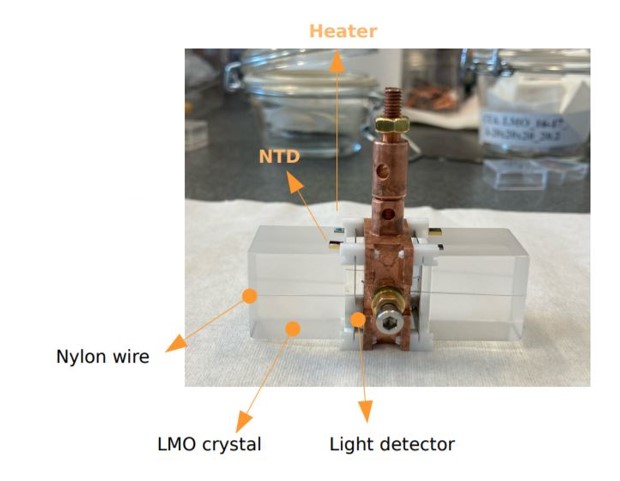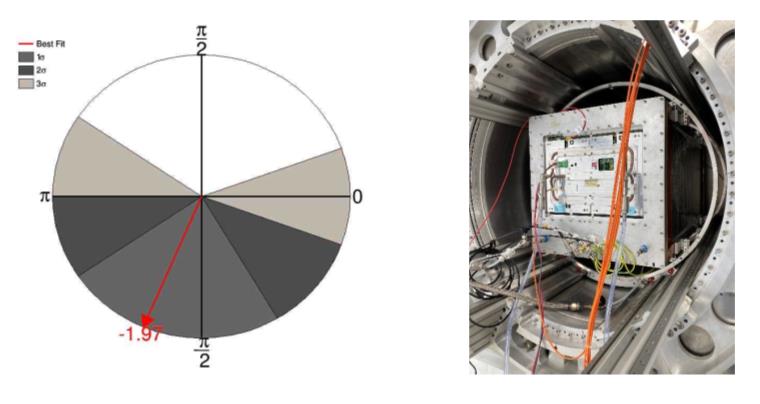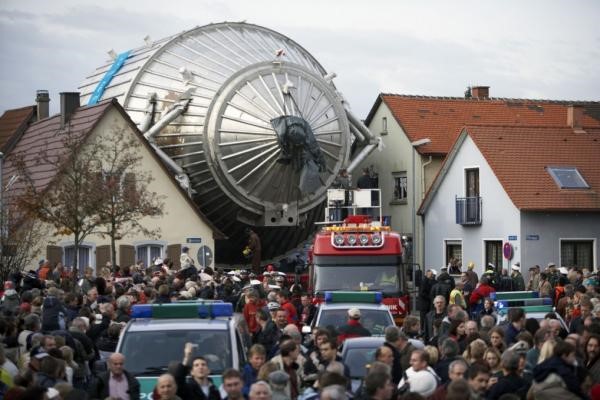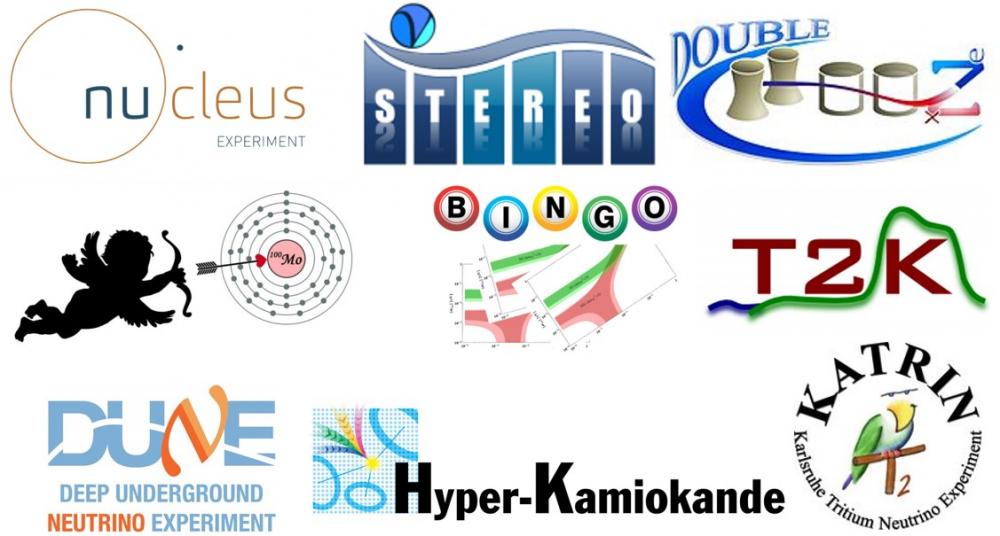
A l'Irfu, la physique des neutrinos est étudiée en utilisant différentes sources comme les réacteurs, les accélérateurs ainsi que les sources radioactives.
At Irfu, neutrino physics is studied using different sources such as reactors, accelerators and radioactive sources.
Irfu teams have been engaged for several decades in a long quest to study the neutrino in all its aspects, to understand its place in the Standard Model of particle physics and even more, but also its contribution to the evolution of the Universe since its first moments. The traditional summer conferences organized last year were an opportunity to measure the progress made by the armada of international experiments with which our institute is working to achieve this ultimate goal. A look back at year 2021, full of lessons and promises for the future...
CUPID and BINGO: or how to break through the nature of the neutrino...
Dirac or Majorana particle? In other words, are the neutrino and its anti-partner, the antineutrino, really two distinct particles or two sides of the same particle? This question, which has been tormenting physicists for several decades and whose the answer could upset the foundations of the Standard Model, shall give reasons for more and more experimental efforts to detect a very rare process called "neutrinoless double beta decay" (0νββ). The observation of this process, which breaks the law of lepton number conservation, would definitely prove that the neutrino is a Majorana particle. It would also inform us about the neutrino mass scale and hierarchy, which are two other questions that remain unanswered at the moment.
The bolometric detection is a promising experimental technique to detect this process. The CUPID (CUORE Upgrade with Particle IDentification) experiment is the next phase of the CUORE experiment, which is a detector installed at the Gran Sasso National Laboratory in Italy operating almost one ton of TeO2 crystals at cryogenic temperatures of the order of 10 mK to search for the 0νββ of 130Te. The innovative principle of CUPID, proposed jointly by Irfu and CNRS/IJCLab teams, is based on the use of a double heat/scintillation readout using new scintillating Li2MoO4 bolometers enriched with 100Mo. The 100Mo, unlike 130Te, is an isotope with very good characteristics to decay according to the 0νββ. This technique will lower the background levels to thresholds that will significantly improve the sensitivity of current experiments.
The CUPID-Mo demonstrator, installed at the Modane Underground Laboratory in 2019 [FM], had been operating in a stable and nominal manner until it was shut down during the past year. The analysis of the latest data, presented for the first time at the TAUP 2021 conference last September, put the best limit ever on the 100Mo half-life time (T1/2 > 1.5 x 1024 years) with only a few hundred grams of detector. The year 2021 proved that the exploitation of CUPID-Mo was a great success, validating the concept retained by the CUPID collaboration to reach the objective of a sensitivity of the order of T1/2 ~ 1027 years.
The neutrino can exist in three flavors (electronic, muonic and tauic), each being the superposition of three mass states. Mass hierarchy consists in classifying each mass state from the lightest to the heaviest. To determine future experiments and to push the sensitivity of the bolometric technique even further, the BINGO project [FM] will be based on a whole range of instrumental developments that will allow to further reduce background in the region of interest region of 0νββ:
- the use of more efficient light detectors to read out scintillation signals
- an innovative detector architecture to drastically reduce surface radioactivity from the assembly materials
- the use of an instrumented cryogenic veto hermetically covering the sensitive detection volume.
The first cryogenic tests of BGO and ZnWO4 scintillating crystals has been successfully carried out this year, and has demonstrated very good performances for the realization of the external cryogenic veto. On the other hand, to replace and reduce the mass of copper usually used in the assembly of detectors, the use of ultra-thin nylon wires has also been validated in cryogenic conditions, suggesting the possibility of using this material in a more systematic way for the assembly of future devices.
There is no doubt that with CUPID and BINGO, bolometric detection of rare events will fully express its potential for the search for 0νββ and perhaps to discover the nature of the neutrino!
Previous Highlight:
T2K: searching for antimatter...
With a beam of muon neutrinos and antineutrinos produced at the J-PARC accelerator located in Tokai on the east coast of Japan, the T2K experiment studies how they respectively transform into neutrinos and antineutrinos of other flavors. The observation of any difference between the oscillation probability of neutrinos and their respective anti-partners, governed by the δCP parameter, would reveal a violation of the CP symmetry linked to the matter-antimatter asymmetry observed in the Universe. A first result published in 2020 by the T2K collaboration, to which the Irfu teams is a major contributor, rejected with nearly 95% confidence the ?CP values preserving this symmetry, , i.e δCP = 0, ± 180° [FM].
There is still a long way to definitely conclude on the existence of CP symmetry violation in the neutrino sector, but the year 2021 has been the occasion for our teams to make several steps toward this goal. Through several instrumental developments, they are preparing the next generation experiments DUNE and Hyper-Kamiokande, and are also working on the improvement of the ND280 detector for the second phase of the T2K experiment. In particular, the integration of new time-projection chambers (TPC) read by detectors based on the resistive Micromegas technology developed at IRFU will allow to significantly improve the performances of this detector for the reconstruction of the tracks and the energy of particles produced during the interaction of neutrinos with matter. A crucial point in the measurement of the δCP parameter is to overcome our lack of knowledge of these interaction processes, which currently limits the sensitivity of the experiment. With the commissioning of this new detector, the second phase of the T2K experiment, which will start next autumn, will be able to fulfill all its promises to study with an increased level of confidence a possible CP symmetry violation in the neutrino oscillation!
Previous highlights:
2020: Where did the antimatter go? Neutrinos shed promising new light.
Publication : https://inspirehep.net/literature/1870215
Reactor neutrinos: Double Chooz and STEREO can see the finish line, NUCLEUS in the starting blocks...:
The Double Chooz (Chooz power plant in the Ardennes) and STEREO (research reactor at the Institut Laue-Langevin in Grenoble) experiments are part of a long tradition of reactor neutrino studies at IRFU, which began in the early 1990s with the famous Bugey experiments. Each with their own innovative design, these two experiments have improved and pushed the method of detection of neutrinos by inverse beta decay to make it a formidable experimental technique in the study of neutrinos produced by nuclear reactors.
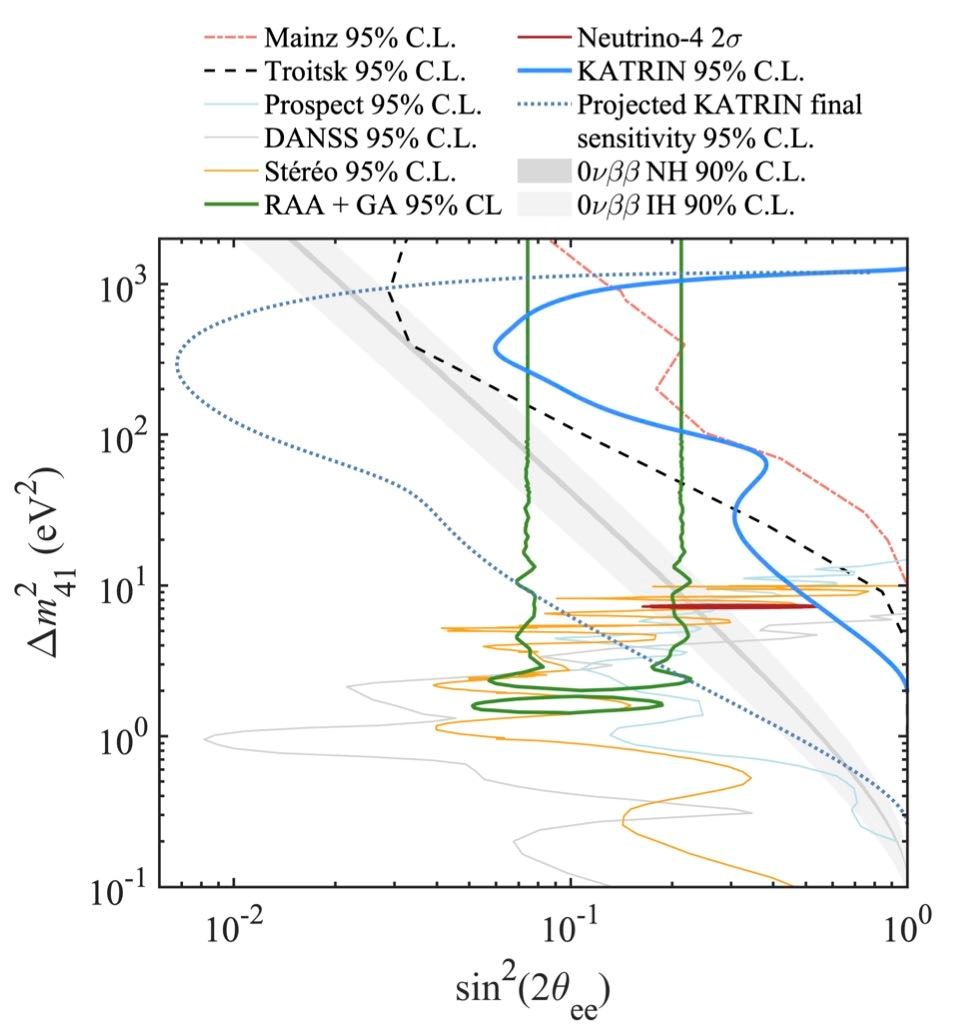
Figure 3: Exclusion plots obtained by STEREO (thin yellow curve) and the main experimental programmes searching for a sterile neutrino at a nuclear reactor. The results obtained by the KATRIN experiment are also superimposed (thick blue curve).
By 2018, Double Chooz had concluded nearly ten years of data taking aimed at measuring the neutrino oscillation mixing angle θ13 before shutting down its two detectors for good [FM]. The measurement of this angle was important not only to complete and confirm the current paradigm describing the oscillation phenomenon, but also for the beam experiments seeking to demonstrate CP symmetry violation in the neutrino sector (see paragraph on T2K). In 2021, the detectors dismantling operations, which had stopped because of the COVID-19 pandemic, has resumed. One of these operations will allow to accurately measure the number of target protons in the gamma catcher in order to improve the final measurement of the θ13 angle.
STEREO's [FM] main motivation is to test the hypothesis of a fourth neutrino family proposed in 2011 by the IRFU teams after having revealed the famous reactor antineutrino anomaly [FM]. The detector, which has been in operation since 2017, completed data taking at the end of 2020, with some 157 000 neutrinos detected, a nice haul for identifying a possible sterile neutrino and making precision measurements. The latest analysis, the results of which were shown for the first time at the TAUP 2021 conference last September, uses the full data-set and excludes with a high level of confidence (> 99.9%) the existence of a sterile neutrino (see Figure 3).
The origin of the reactor neutrino anomaly is therefore rather to be found in a bias in the predictions, which are based on a complex set of nuclear data and models. In addition to this important result, the collaboration has also provided a new reference neutrino spectrum from 235U fission. Direct neutrino measurements are now superseding predictions and feeding future reactor-based experimental programs, such as the NUCLEUS experiment.
NUCLEUS, the latest brainchild of the IRFU teams, is a bolometric reactor neutrino detection experiment based on the process of coherent scattering of neutrinos on nuclei. This new detection method will not only miniaturise the current detection devices, but will also push the study of the fundamental properties of the neutrino towards very low energies, an area that is still barely explored for research into physics beyond the Standard Model. In 2021, the signing of a bilateral agreement between the CEA and EDF has secured access to an experimental site ideally located between the two cores of the Chooz power plant. In 2022, NUCLEUS will set up the site and carry out the first blank assembly of the experiment at the Technical University of Munich. It should be noted that IRFU is also making an original and essential contribution to this new theme with the innovative CRAB method for calibrating the NUCLEUS cryogenic detectors in the sub-keV energy range [FM]. NUCLEUS is scheduled to move to Chooz in 2023 for the first detection of reactor neutrinos using this revolutionary technique!
Previous highlights:
KATRIN: a heavyweight seeking to weigh a featherweight...
A cathedral of two hundred tonnes of steel, magnets, electronics, pipes and cables of all kinds... This is what an international collaboration of nearly 200 physicists, engineers and technicians has been working on for nearly 20 years at the Karlsruhe Institute of Technology in Germany. It is a jewel of technology and recognised know-how, designed to guide and measure with unprecedented precision the electrons emitted during the beta decay of a tritium source. Why do we build such a huge instrument? To solve the enigma of the neutrino mass and perhaps thus understand its true nature! The neutrino oscillation phenomenon tells us that neutrinos have a non-zero mass, at least 500 000 times less than the electron. Why such a low mass? And by what mechanism does it acquire it? These are essential questions that the giant spectrometer of the KATRIN (Karlsruhe Tritium Neutrino experiment) is tackling.
A first important step was taken in 2018 with the commissioning of the spectrometer and the tritium source [FM]. In 2019, under the impetus of the IRFU teams, a first measurement was made using four weeks of data and constraining the neutrino mass to less than 1.1eV (at 90% confidence level). This was a promising result that already improved by a factor of two on previous experimental results when the spectrometer and its source were not yet operating at nominal performance [FM]. The same data also allowed the existence of a sterile neutrino to be tested in 2020 [FM], an original analysis that is complementary to the experimental programs underway at nuclear reactors (see section on reactor neutrinos and Figure 3). There is no trace of a possible fourth neutrino in these data, confirming the results obtained by STEREO in particular. More recently, the year 2021 has been an opportunity for the collaboration to better understand and improve the performance of the instrument to fully meet its objectives. Since then, it has continued to build up the statistics to put the neutrino on the scale once again. The next results are expected in 2022.
Previous highlights:
- oct 2018 First injection of tritium in the KATRIN experiment
- dec 2020 KATRIN: a still unsterilized scale!
Contacts Irfu:
Claudia Nones (Cupid), Sara BOLOGNESI (T2K), Matthieu VIVIER (reactor neutrinos), Thierry LASSERRE (Katrin)
• The ultimate constituents of matter › Neutrino Physics
• The Electronics, Detectors and Computing Division • The Particle Physics Division



